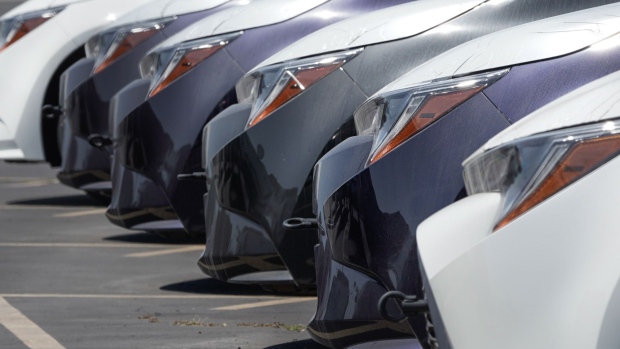Feb 8, 2023
Toyota Keeps Profit Outlook as Supply Chain Challenges Persist
, Bloomberg News

(Bloomberg) -- Toyota Motor Corp. posted third-quarter profit that topped estimates, but kept its conservative outlook for the year intact in the face of stubborn component shortages ahead of a change in leadership.
Profit for the fiscal quarter ended December topped rose 22% to ¥957 billion ($7.3 billion) from a year earlier, exceeding analysts’ average projection for ¥747 billion. For the fiscal year ending March, operating profit is on track to reach ¥2.4 trillion, in line with the prior forecast, the company said Thursday.
After 14 years at the helm, Chief Executive Officer Akio Toyoda is preparing to become executive chairman and cede his current role in April to Koji Sato, who runs the Lexus luxury-car division. Apart from keeping production intact while shortages persist for parts and semiconductors, Sato will have to guide Toyota into a new era of electrification and driverless vehicles.
Read more: Lexus Chief’s Ascension Comes at Make-or-Break Moment for Toyota
Toyota is sticking to its outlook in the face of “soaring materials and energy prices,” even after quarterly profit benefited from higher volumes and a weaker yen that boosted income brought home. It’s seeking to “quickly evaluate alternative semiconductors and respond to design changes for securing stable procurement,” underscoring the persistent automotive chip shortage that has been a drag on the global industry. The carmaker kept its forecast for output of 10.4 million units.
“Third-quarter earnings were expected to be high but perhaps not this much,” said Tatsuo Yoshida, a Bloomberg Intelligence analyst. Based on Toyota’s low expectations for the dollar and euro, as well as cost-cutting efforts, operating profit will probably exceed the outlook for the fiscal year, he added.
“There’s room for upward movement,” Yoshida said.
Shares in Toyota reversed losses and rose as much as 1.3% after the results. The stock is up about 6% this year, after declining 14% in 2022.
Sales for the 12 months ending March will be ¥36 trillion, in line with the prior forecast, the company said. For the latest quarter, revenue rose 25% to ¥9.75 trillion.
Sato will take over as production recovers from Covid-induced lockdowns, supply-chain snarls and component shortages. Toyota expects output to exceed pre-pandemic levels in 2023, forecasting asseembly of as many as 10.6 million vehicles. At the same time, it warned that final shipments could be 10% lower if it is unable to procure enough parts, especially chips.
Toyota recently solidified its status as the world’s largest carmaker for the third consecutive year, having sold 10.5 million units in 2022, widening its lead over Volkswagen AG.
Read more: Toyota Keeps Title as No. 1 Carmaker for Third Straight Year
Although the weak yen helps Japan’s carmakers boost the competitiveness of vehicles sold abroad and the value of earnings brought back home, they don’t get as much benefit as they used to because the weaker yen also increases imported costs of raw materials and energy.
In China, Toyota lowered the price of the bZ4X SUV by 30,000 yuan ($4,420), a battery-electric model introduced four months ago, according to a post on the Weibo account of its joint venture with GAC.
Toyota’s price cut follows that of other Chinese companies including Xpeng Inc., Nio Inc. and SAIC-GM-Wuling Automobile Co., after Tesla Inc. kicked off a price war in January.
(Updates with China price cut in final paragraph.)
©2023 Bloomberg L.P.





